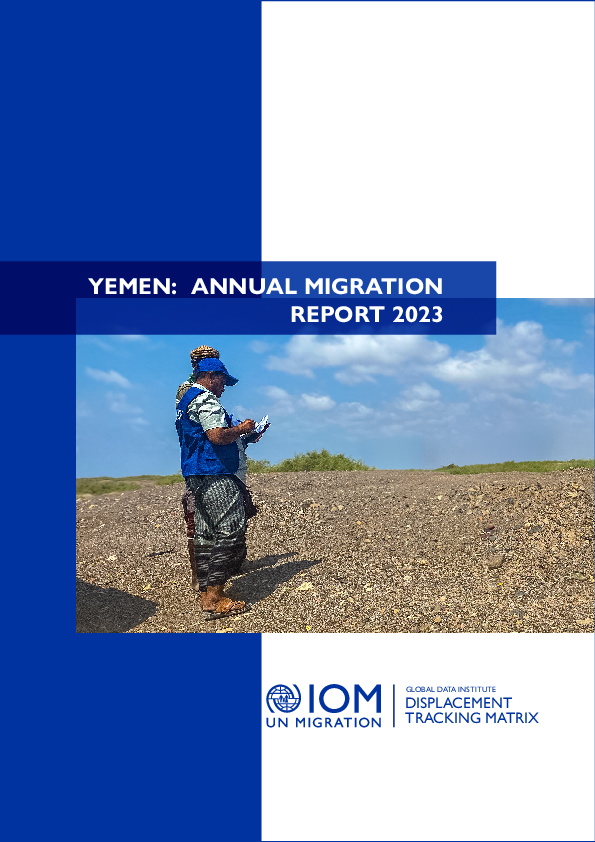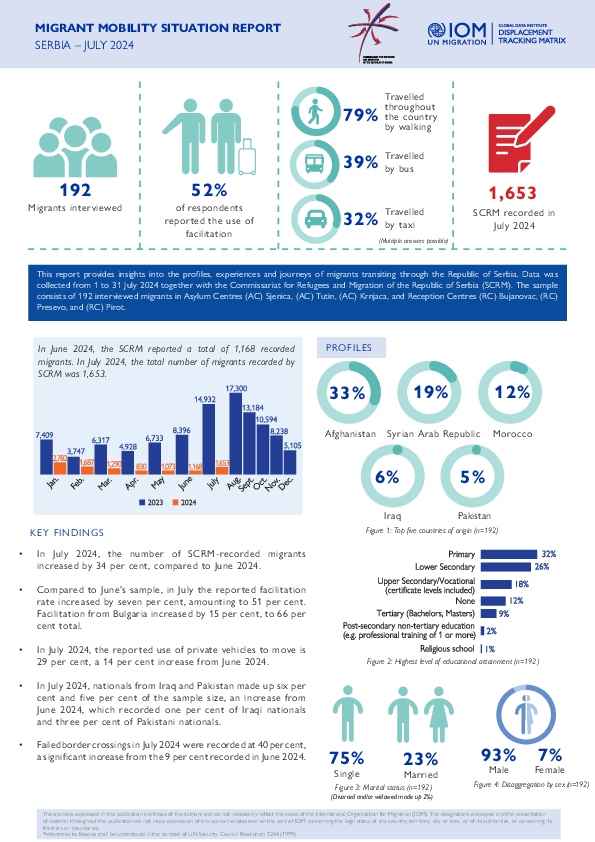-
Countries
-
Data and Analysis
-
Special Focus
-
Crisis Responses
Assessment Report

Contact
DTM Europe, DTMMediterranean@iom.int
Language
English
Location
Montenegro
Period Covered
Jan 01 2024
Mar 31 2024
Activity
- Survey
- Flow Monitoring Survey
- Flow Monitoring
This report, based on a questionnaire administered through a Kobo toolbox, provides insights into the profiles, experiences, needs, routes travelled and intentions of migrants transiting through Montenegro. Data was collected from 1 January to 31 March 2024. IOM surveyed 319 migrants in Reception Centers Božaj and Spuž, and active transit locations such as bus stops or at key entry and exit locations (Rožaje and Pljevlja) throughout the country.

Contact
mtmkyrgyzstan@iom.int
Language
English
Location
Kyrgyzstan
Period Covered
Feb 27 2024
Apr 12 2024
Activity
- Mobility Tracking
- Baseline Assessment
DTM implements the Baseline Mobility Assessment (BMA) in Kyrgyzstan to track mobility, provide information on population estimates, geographic distribution of migrant workers and return migrants, reasons for migration and countries of return. Data is collected at the village level from key informants and direct observations.
The Baseline Mobility Assessment (BMA) was conducted in all seven oblasts or provinces (Batken, Chui, Issyk-Kul, Jalal-Abad, Naryn, Osh, and Talas) including all 40 rayons or districts within these oblasts, and the two major cities of Kyrgyzstan (Bishkek city and Osh city including the four rayons within Osh city). This assessment covered 999 communities through interviews with 1,159 key informants. Based on the key informants' estimates, 34,966 international migrant workers have been hosted in the assessed communities in Kyrgyzstan from 2020 to April 2024. Concurrently, 44,391 internal migrants are hosted in the assessed communities and 227,629 Kyrgyz nationals are reported to be residing abroad as emigrants. In addition, 128,661 migrants have returned from abroad.

Contact
DTM Yemen, DTMYemen@iom.int
Language
English
Location
Yemen
Period Covered
Jan 01 2023
Dec 31 2023
Activity
- Flow Monitoring
Despite the domestic conflict that broke out in 2015 followed by economic decline and institutional collapse, Yemen remains a frequently travelled transit country for migrants.
According to IOM’s DTM Area Assessment Report in September 2023, Yemen hosts over 42,000 migrants across accessible locations in ten of the 12 assessed IRG controlled governorates.6 The majority of migrants living in Yemen came from Ethiopia (88%) in addition to 12 per cent from Somalia and less than one per cent from other countries according to this stock figure. Please note that information on migrant stocks will differ from data on migration flows as migrants tend to remain in Yemen for months to years before moving on to further destinations. In the same year, a total of 96,670 migrants, 79 per cent Ethiopian and 21 per cent Somali nationals, were observed traveling towards Yemen.7
Migration in the HoA continues to be triggered by persistent insecurity and conflict, environmental degradation, harsh climatic conditions, public health emergencies, socioeconomic drivers, and traditional seasonal factors. Recognizing the importance of information about migrants in Yemen and it mixed flows, the IOM DTM team in Yemen aims to report on migration statistics and drivers throughout this report. This Yemen Annual Migration Report 2023 is presenting information on the flow of migrants to Yemen (Non-Yemeni and returnee Yemeni migrants) at transit, departure or arrival points, the profile of migrants who live in various locations in Yemen, challenges faced by migrants, and their intentions.
In light of the above objectives, the report is organized according to the following sections. Following key findings, the first section on flows presents the migrant arrivals (non-Yemeni and returnee Yemeni migrants) and trends. This section also includes the routes they took and drivers. The subsequent section on migrant profiles presents findings on migration networks, migratory drivers, migrant backgrounds, routes and challenges during migration journeys. This section also summarizes information on intentions. The last section on stocks focuses on numbers and locations of migrants living in Yemen and their immediate needs.

Contact
IOMKenyaDRU@iom.int
Language
English
Location
Kenya
Period Covered
Apr 29 2023
May 16 2023
Activity
- Mobility Tracking
- Baseline Assessment
In May 2023, Mobility Tracking was conducted in Garissa County, Kenya. Key findings are presented herein.
In all locations, arrivals were displaced into communities that already were under severe resource constraint as a result of drought, resource-based conflict and ethnic clashes.
In nearly all locations (99%) respondents noted that previously pastoralist households had dropped pastoralism as a way of life. This finding represents a dramatic shift in the culture and livelihoods of Kenyan populations.
DTM identified 10,158 child-headed households. Of these,81 per cent had no form of sustainable support, including income, food, water or shelter. Nearly one-quarter (22%) of school-aged children had dropped out of school in Garissa in 2023, despite 96% of institutions remaining open despite the drought

Contact
DTM Europe, DTMMediterranean@iom.int
Language
English
Location
Slovakia
Period Covered
Apr 01 2024
Jun 30 2024
Activity
- Survey
- Return Intention
- Flow Monitoring
IOM’s Displacement Tracking Matrix (DTM) collected data on Ukrainian nationals and Third-Country Nationals (TCNs) that crossed back to Ukraine from or through Slovakia, either temporarily or permanently. The survey focuses on the return intentions, duration of displacement, destinations, assistance, and experiences of discrimination of respondents. A total of 1,467 surveys were collected between April and June 2024.
Key findings:
- 30% of Ukrainian respondents intend to stay in Ukraine (prospective returnees), while 64% plan to go for a short visit.
- The share of those intending to return to Ukraine is higher among men than women (42% vs 30%). Women are more likely to be crossing into Ukraine for a short visit than men (64% vs 53%).
- Most of the short-term visitors plan to stay in their own home in Ukraine (86% overall), while others report to be going to their relatives’ homes (6%), finding other private solutions (6%) or staying with friends (2%). The share of those planning to stay with relatives is higher among short-term visitors (20%) than among prospective returnees (3%)
- Reasons for returning for prospective returnees include: visit relatives or close friends (73%), meet with family members (14%), reunite with their family (5%).
- Reasons for returning for short-term visitors include: visit family members (80%), healthcare (32%), help family (20%).
- 64% of the Ukrainian nationals originate from seven regions in Ukraine: Zakarpatska (29%), Kyiv (15%), Kharkivska (7%), Dnipropetrovska (7%), and Lvivska (6%). The remaining 36% of respondents come from another 20 regions across Ukraine.

Contact
dtmlebanon@iom.int
Language
English
Location
Lebanon
Period Covered
Oct 10 2023
Aug 20 2024
Activity
- Mobility Tracking
- Baseline Assessment
Since October 8 there has been an increase in cross-border incidents between Israel and Lebanon, resulting in the displacement of people both within the South and elsewhere within the country. Since October 10, the Displacement Tracking Matrix (DTM) has been conducting the daily monitoring of population movements. The objective of the exercise is to inform preparedness and response planning.

Contact
DTM Europe, DTMMediterranean@iom.int
Language
English
Location
Serbia
Period Covered
Jul 01 2024
Jul 31 2024
Activity
- Survey
- Flow Monitoring
This report provides insights into the profiles, experiences and journeys of migrants transiting through the Republic of Serbia. Data was collected from 1 to 31 July 2024 together with the Commissariat for Refugees and Migration of the Republic of Serbia (SCRM). The sample consists of 192 interviewed migrants in Asylum Centres (AC) Sjenica, (AC) Tutin, (AC) Krnjaca, and Reception Centres (RC) Bujanovac, (RC) Presevo, and (RC) Pirot.

Contact
DTM Europe, DTMMediterranean@iom.int
Language
English
Location
Bosnia & Herzegovina
Period Covered
Jul 01 2024
Jul 30 2024
Activity
- Flow Monitoring
This report provides insights into the profiles, experiences, needs, routes travelled and intentions of migrants transiting through Bosnia and Herzegovina (BiH). Data was collected from 1 to 30 July 2024. IOM carried out a route observation exercise in the Republika Srpska, Sarajevo Canton, Posavina Canton, Tuzla Canton, Bosnian-Podrinje Canton and Una Sana Canton to monitor trends in entries and exits as well as transit modalities within BiH. IOM also surveyed 32 migrants in active transit locations such as bus stops or at key entry and exit locations throughout the country as well as in four transit reception centres (TRCs) in BiH (Lipa, Ušivak, Borići and Blažuj).

Contact
DTM Peru, IOMDTMPeru@iom.int
Language
English
Location
Peru
Period Covered
Jul 01 2024
Jul 31 2024
Activity
- Flow Monitoring
Este reporte brinda información sobre el volumen de las poblaciones que transitan durante las horas de observación en tres puntos fronterizos del Perú (Tumbes, Tacna y Desaguadero). A través de esta herramienta se recopila información una vez a la semana y estima el volumen de los flujos observados.
Pagination
- Previous page
- Page 13
- Next page

